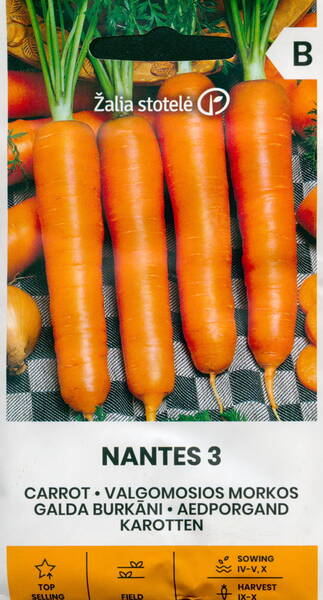Nanto type hybrid. Grows best in easy, highly cultivated sandy and clay loam soils. A very fertile nanto type kind, it grows best in cultivated, humus, not soaked, light clay loam or sandy loam soils. A medium-earliness kind. Crop can be harvested after 110-120 days. Root vegetables are 16-20 cm long, with straight surface, thin core and blunt ends. Suitable for fresh consumption, preparing salads and juice and storage during winter because they contain lots of sugar and carotene. 1g contains approximately 800-1000 seeds.
The best predecessors for carrots are: tomatoes, cucumbers, potatoes, onions, legumes.
Care: after emergence, care consists of weeding, deep loosening, watering and fertilizing. Carrots are thinned out 2 weeks after germination.
The second thinning with a root diameter of 1 cm, leaving 5-6 cm between plants.
* Carrots are a cold-resistant crop. Placed on light loamy and sandy loam soils. Sowed from late April to early June.
To obtain an early harvest, winter sowing is carried out at the end of October. The depth of seed placement is 1-2 cm, depending on the type of soil.
Seeds begin to germinate at a temperature of +3+4 °C. It is important to keep the soil moist. The first thinning is in the phase of the first pair of true leaves, the second – in the phase of bunch ripeness. The optimal temperature for the growth and formation of root crops is +20+22 °C. Watering and loosening - as needed.
Harvesting root crops from July to early October.

...The soil for sowing carrots should be prepared in the fall. Make ridges 15 - 18 cm high (in spring, on such ridges the soil warms up and ripens faster). For digging in the fall you need to add 1 sq. m 25 g of superphosphate and 20 g of potassium salt.
...In the spring, the ridges need to be dug up again, adding 15 g per square meter. m of ammonium nitrate, level and lightly compact. If the soils are very poor, in the fall they add organic matter (compost, humus, peat, rotted manure) at 4 - 5 kg per 1 sq. m. m.
...Before sowing, carrot seeds are soaked to obtain quick and friendly shoots. Soaking the seeds is carried out in clean tap water for 1 - 1.5 days, changing the water 3 - 4 times during this time. Then the seeds are scattered onto a cloth in a small layer and dried until they become loose.
...Mid-season carrot varieties are sown early in the spring, and early varieties - 2 weeks later, so that the root crops do not outgrow by the time of harvesting. Overgrown root vegetables crack, are poorly stored and lose their valuable taste and nutritional qualities.
...When sowing carrots before winter, you can get root crops 15 days earlier. The beds for such sowing are prepared in the fall. With the onset of the first frosts (October-November), dry carrot seeds are sown in furrows, sprinkled with a thin layer of soil (1 cm), and mulched on top with peat or humus with a layer of 3 - 4 cm. The sowing rate of carrot seeds when sowing before winter is increased by 20 - 25 percent. For 1 sq. m, at least 1 gram of seeds is sown.
...In spring, carrots are sown in furrows on the beds. The distance between the grooves is 20 cm. The seed sowing rate is 0.8 g/sq.m. m. The furrows are covered with a 2 cm layer of earth and mulched with peat or humus. Carrot seedlings appear on the 14th - 15th day. When seedlings appear, after 10 days the first fertilizing is carried out with ammonium nitrate - 20 g/sq.m. m, between rows with embedding in the soil. If the soil is dry, then after fertilizing the crops must be well watered.
...Plant care consists of loosening, destroying the crust that forms after rains, weeding, thinning crops, fertilizing and watering. Carrots do not tolerate weeds well: to get a good harvest, it is important to keep the crops clean.
...The first thinning of carrots is carried out when the first true leaves appear. The distance between plants is left 1 - 1.5 cm. The second thinning is carried out 15 days after the first. After the second thinning, the distance between plants should be 3 - 4 cm. After each thinning, the plants must be watered. After the second thinning, the plants are fed with phosphorus-potassium fertilizers: 20 g of potassium salt and 25 g of superphosphate per 1 sq. m.
...It is necessary to water carrots in a timely manner, especially in the first phases of plant development, because... If there is a lack of moisture, plant growth is retarded, and the root crops turn out small and ugly.
















